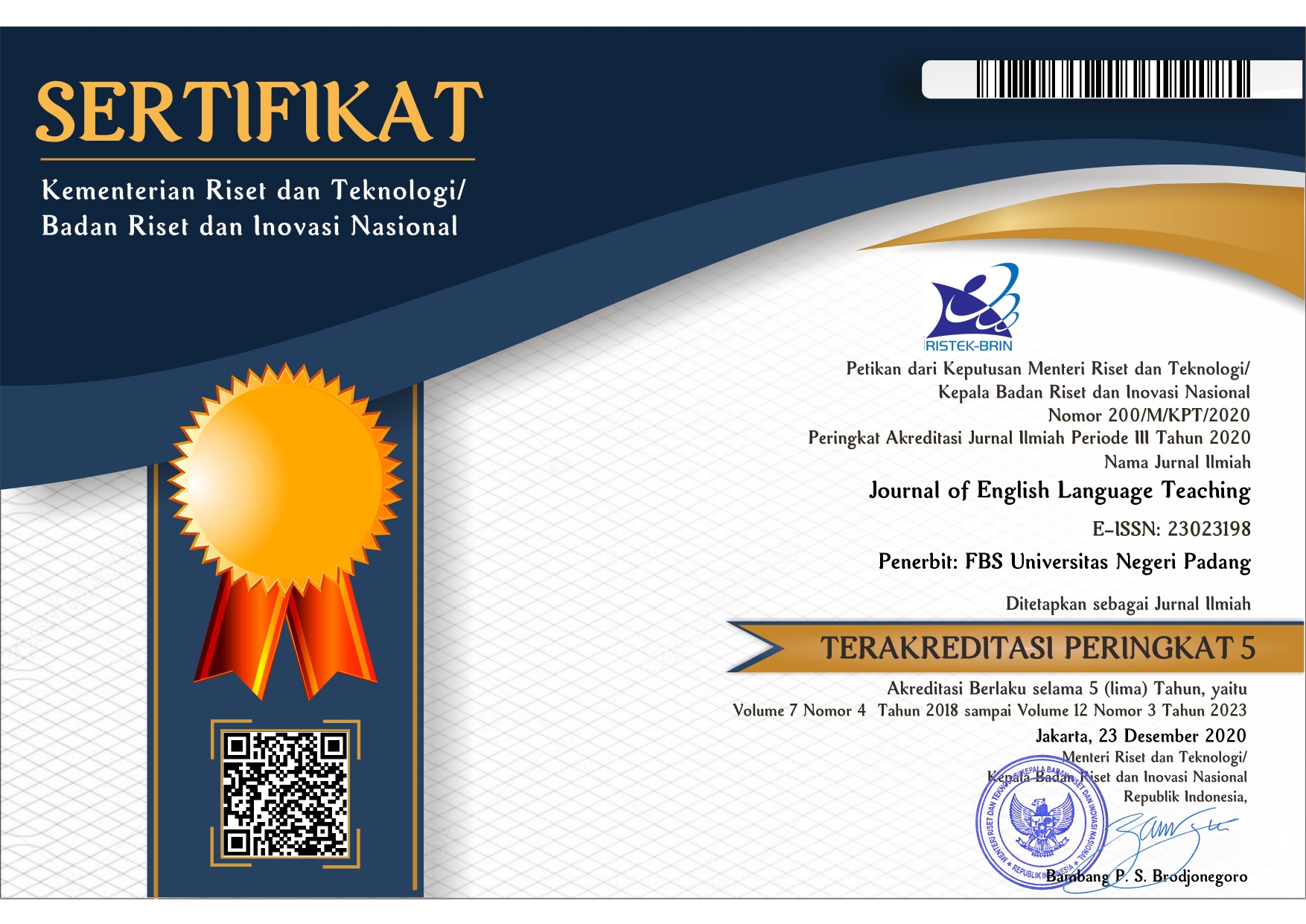The Relationship between Listening Anxiety and Listening Comprehension of English Department Students in Basic Listening Classes at Universitas Negeri Padang
 ), Aryuliva Adnan(2), Leni Marlina(3),
), Aryuliva Adnan(2), Leni Marlina(3), (1) Universitas Negeri Padang
(2) Universitas Negeri Padang
(3) Universitas Negeri Padang
 Corresponding Author
Corresponding Author
Copyright (c) 2020 Journal of English Language Teaching
DOI : https://doi.org/10.24036/jelt.v9i3.109344
Full Text:
 Language : en
Language : en
Abstract
Listening anxiety which makes someone feel tensions, fear, uncomfortable, and worry was suspected to affect students' comprehension in listening class. Therefore, this research aims to find the relationship between listening anxiety and listening comprehension of English department students who had taken the Basic Listening class at Universitas Negeri Padang. The type of research used in this research was quantitative research. The population of this research was the second-year students in Basic Listening Class of English Department. The sample was 60 students who were chosen randomly from the total population using Simple Random Sampling. The data were collected through a questionnaire and an English listening comprehension test using Basic Listening final examination test. The results showed that Foreign Language Listening Anxiety (FLLA) and Listening Comprehension (LC) have a negative correlation (r= -.245) which indicates that high anxiety blocks the processing of listening comprehension, and when the higher anxiety the students have, the lower listening comprehension they get. Further research related to listening comprehension and listening anxiety is suggested to do.
Keywords
References
Ahmadi, S. M. (2016). The Importance of Listening Comprehension in Language Learning. International Journal of Research in English Education, 1(1), 7–10. Retrieved from http://ijreeonline.com/browse.php?a_code=A-10-1-2&
Al-Sawalha, A. M. (2016). Qualitative and quantitative study on listening anxiety of Jordanian students majoring in English language at Jerash University. International Journal of Humanities and Social Science, 6(1), 82–93.
Bögels, S. M., Alden, L., Beidel, D. C., Clark, L. A., Pine, D. S., Stein, M. B., & Voncken, M. (2010). Social anxiety disorder: questions and answers for the DSM‐V. Depression and Anxiety, 27(2), 168–189.
Chastain, K. (1998). Developing Second Language skills (3rd U.S.A:). Chavira, D. A., Stein, M. B., & Malcarne, V. L. (2002). Scrutinizing the relationship between shyness and social phobia. Journal of Anxiety Disorders, 16(6), 585–598.
Chen, Y.-L., & Tsou, S.-Y. (2017). Learners’ anxiety in EFL context among Taiwanese colleges. Res. Psychol. Behav. Sci, 5(2), 57–60.
Corr, P. J., & Fajkowska, M. (2011). Introduction to special issue on anxiety. Personality and Individual Differences, 50(7), 885–888.
Cutler, A., & Clifton, C. E. (1999). of Book: The neurocognition of language. Oxford University Press.
Dörnyei, Z. (2005). The Psychology of The English Language Learner Individual Differences in Second Language Acquisition. London: Lawrence Elbraum Associates Publishers.
Ellis, R. (1994). The study of second language acquisition. Oxford: Oxford University Press.
Golchi, M. M. (2012). Listening anxiety and its relationship with listening strategy use and listening comprehension among Iranian IELTS learners. International Journal of English Linguistics, 2(4), 115.
Gonen, M. (2009). The relationship between FL listening anxiety and FL listening strategies: The case of Turkish EFL learners. Proceedings of the 5th WSEAS/IASME International Conference on Educational Technologies, 44–49.
Grös, D. F., Antony, M. M., Simms, L. J., & McCabe, R. E. (2007). Psychometric properties of the state-trait inventory for cognitive and somatic anxiety (STICSA): comparison to the state-trait anxiety inventory (STAI). Psychological Assessment, 19(4), 369.
Hamouda, A. (2013). An investigation of listening comprehension problems encountered by Saudi students in the EL listening classroom. International Journal of Academic Research in Progressive Education and Development, 2(2), 113–155.
Hang, Y. (2006). Listening comprehension anxiety: Students reported sources and solutions. CELEA Journal, 29(5), 100–115.
Heale, R., & Twycross, A. (2015). Validity and reliability in quantitative studies. Evidence-Based Nursing, 18(3), 66–67.
Horwitz, E. K. (2001). Language anxiety and achievement. Annual Review of Applied Linguistics, 21, 112–126. https://doi.org/doi:10.1017/S0267190501000071
Horwitz, E. K., Horwitz, M. B., & Cope, J. (1986). Foreign language classroom anxiety. The Modern Language Journal, 70(2), 125–132.
Kumar, R. (2011). Research Methodology (3rd Editio). London: SAGE Publication.
Liebert, R. M., & Morris, L. W. (1967). Cognitive and emotional components of test anxiety: A distinction and some initial data. Psychological Reports, 20(3), 975–978.
MacIntyre, P. D., & Gardner, R. C. (1994). The subtle effects of language anxiety on cognitive processing in the second language. Language Learning, 44(2), 283–305.
McCroskey, J. C. (1984). The communication apprehension perspective. Avoiding Communication: Shyness, Reticence, and Communication Apprehension, 13–38.
Musa, M.K, Hashim, M.Z, Muhamad, S. and Mohamed, R. (2013). LANGUAGE LEARNING ANXIETY: MALAY UNDERGRADUATES LEARNING JAPANESE. 2nd UPALS International Conference on Languages, 325–335.
O’Malley, M. J., & Chamot, A. U. (1990). Learning strategies in second language acquisition. Cambridge university press.
Pan, Y. E. (2016). Analysis of Listening Anxiety in EFL Class. International Journal on Studies in English Language and Literature, 4(6), 12–16. https://doi.org/10.20431/2347-3134.0406002
Rink, J. (2002). Musical performance: A guide to understanding. Cambridge University Press.
Schwartz, C. E., Snidman, N., & Kagan, J. (1999). Adolescent social anxiety as an outcome of inhibited temperament in childhood. Journal of the American Academy of Child & Adolescent Psychiatry, 38(8), 1008–1015.
Shu-Yan, W., & Cha, K.-W. (2019). Foreign Language Listening Anxiety Factors Affecting Listening Performance of Chinese EFL Learners. Journal of Asia TEFL, 16(1), 121.
Spielberger, C. D. (1966). Theory and research on anxiety. Anxiety and Behavior, 1(3).
Tahsildar, M. N., & Yusoff, Z. S. (2014). Investigating L2 students’ listening anxiety: A survey at a Malaysian university. International Journal of Language Education and Applied Linguistics.
Toth, Z. (2010). Foreign language anxiety and the advanced language learner: A study of Hungarian students of English as a foreign language. Cambridge Scholars Publishing.
Whiting, S. E., Jenkins, W. S., May, A. C., Rudy, B. M., Davis III, T. E., & Reuther, E. T. (2014). The role of intolerance of uncertainty in social anxiety subtypes. Journal of Clinical Psychology, 70(3), 260–272.
Wong, A. (2015). The Act of Listening: The processes involved in listening comprehension.
Yusnida, Muslem, and M. (2017). A Study of Teaching Listening. English Education Journal (EEJ), 8(4), 438–456.
Zeidner, M. (2014). Anxiety in education. In R. Perkun & L. Linnenbrink-Garcia (Eds.). In International handbook of emotions in education. New York: Routledge.
ZHAI, L. (2015). Influence of anxiety on English listening comprehension: An investigation based on the freshmen of English majors. Studies in Literature and Language, 11(6), 40–47.
 Article Metrics
Article Metrics
 Abstract Views : 1701 times
Abstract Views : 1701 times
 PDF Downloaded : 368 times
PDF Downloaded : 368 times
Refbacks
- There are currently no refbacks.
Copyright (c) 2020 Journal of English Language Teaching

This work is licensed under a Creative Commons Attribution-NonCommercial 4.0 International License.
















